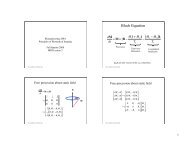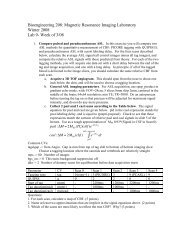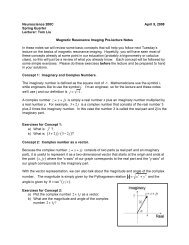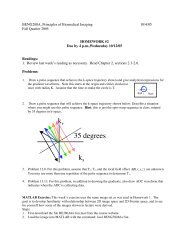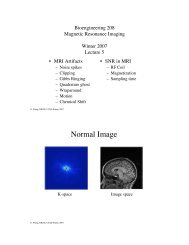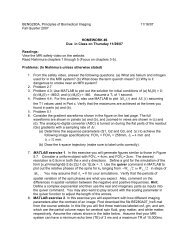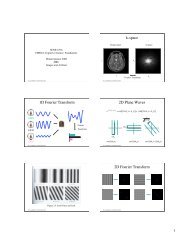Homework 2 - Center for Functional MRI
Homework 2 - Center for Functional MRI
Homework 2 - Center for Functional MRI
You also want an ePaper? Increase the reach of your titles
YUMPU automatically turns print PDFs into web optimized ePapers that Google loves.
BENG280A, Principles of Biomedical Imaging 10/10/12<br />
Fall Quarter 2012<br />
HOMEWORK #2<br />
Due at 5 pm on Wednesday 10/17/12<br />
<strong>Homework</strong> policy: <strong>Homework</strong>s can be turned in during class or to the TA’s mailbox in the Graduate<br />
Student Lounge. Late homeworks will be marked down by 20% per day. If you know that you need to<br />
turn in a homework late because of an emergency or academic travel, please let the TA know ahead of<br />
time. Collaboration is encouraged on homework assignments, however, the homework that you submit<br />
should reflect your own understanding of the material.<br />
Readings: Skim sections 2.1, 2.2, and 3.1-3.5 (read this <strong>for</strong> general understanding, you can skip pages<br />
32-34). Read sections: 4.1-4.5, 5.1-5.5, 5.6.2. View the <strong>MRI</strong> safety video on the website.<br />
Problem 1<br />
From the safety video, answer the following questions: (a) What are helium and nitrogen used <strong>for</strong> in the<br />
<strong>MRI</strong> system (b) What does the term quench mean (c) Why is it dangerous to smoke near an <strong>MRI</strong><br />
system Find a example (on the web) of a large object that’s been pulled into the magnet and include a<br />
copy of the image.<br />
Problem 2<br />
a) Prove the 1D version of the Hermitian Symmetry property (Equation 2.8 in the book).<br />
b) Explain why this property makes sense (Hint: think about how much in<strong>for</strong>mation is in each<br />
domain).<br />
c) Prove the 2D version of the Hermitian symmetry property F *(−k x<br />
,−k y<br />
) = F(k x<br />
,k y<br />
) where the<br />
underlying object f(x,y) is real and * denotes complex conjugation.<br />
d) Show that the Hermitian symmetry property holds <strong>for</strong> the function cos(2π(x + 2y) + 5π /4). In<br />
addition, sketch the function and its Fourier trans<strong>for</strong>m<br />
Problem 3<br />
a) Derive the Fourier shift property F[g(x − a, y − b)] = G(k € x<br />
,k y<br />
)e − j2π (k xa+k y b)<br />
b) Sketch the object m(x, y) = rect(x +1, y +1)− rect(x −1, y −1)<br />
c) Use the Fourier shift property to derive the Fourier trans<strong>for</strong>m of the object. Make sure to<br />
simplify your expression.<br />
d) Sketch the Fourier trans<strong>for</strong>m – indicate key features (e.g. peaks and valleys) and find the spacing<br />
between the peaks.<br />
e) Evaluate the expression <strong>for</strong> the Fourier trans<strong>for</strong>m at the following coordinates in k-space: 0,0<br />
! 1<br />
( 1,−1) , and<br />
8 , 1 $<br />
# & . For each point, draw quiver diagrams (you can do this by hand or with<br />
" 8%<br />
MATLAB) and explain how these are consistent with the value of the Fourier trans<strong>for</strong>m.<br />
( ) ,<br />
MATLAB exercise on the next page
Problem 4 – MATLAB exercise<br />
In this exercise we will examine the Fourier trans<strong>for</strong>ms of some simple test objects.<br />
Part 1. Create a script with the following code<br />
%Define a test object<br />
span = -16:15;<br />
nvox = length(span);<br />
[x,y] = meshgrid(span,span);<br />
obj = zeros(nvox,nvox);<br />
obj([1:8 17:24],:) = 1;<br />
%Define k-space coverage<br />
dk = 1/32;kmax = 0.5;<br />
kspan = -kmax:dk:(kmax-dk);<br />
Nk = length(kspan);<br />
[kx,ky] = meshgrid(kspan,kspan);<br />
%Brute-<strong>for</strong>ce computation of the Fourier Trans<strong>for</strong>m<br />
% This is not the best way to compute it, but is helpful <strong>for</strong> showing the<br />
% process<br />
j = sqrt(-1);<br />
<strong>for</strong> ix = 1:Nk<br />
<strong>for</strong> iy = 1:Nk;<br />
g = exp(-j*2*pi*(kx(ix,iy)*x + ky(ix,iy)*y));<br />
f = sum(sum(g.*obj)); % Fourier Trans<strong>for</strong>m<br />
fmat(ix,iy) = f; %Store the Fourier trans<strong>for</strong>m values in fmat<br />
end;<br />
end<br />
Part 2. Use imagesc to plot images of the object and its Fourier trans<strong>for</strong>m.<br />
Part 3. Find the 3 highest absolute values in the Fourier trans<strong>for</strong>m.<br />
a) Where in k-space do these occur (i.e. provide the values of kx and<br />
ky).<br />
b) Draw the quiver diagrams showing orientation of phasors corresponding to<br />
each of these points in k-space.<br />
c) Create a second set of quiver diagrams that takes into account the<br />
knowledge of the object (i.e. where the object is equal to zero, the<br />
product of the object and the phasor is zero). Based on the<br />
orientation of the phasors in the quiver diagrams and the knowledge of<br />
the object, provide an explanation of why the 3 highest values are<br />
observed at these points in k-space.<br />
d) Compute and plot the vector sum of the phasors in the quiver diagrams<br />
from part c <strong>for</strong> each of the 3 points in k-space. Verify that the vector<br />
sum is equal to the value of the Fourier trans<strong>for</strong>m at the corresponding<br />
points in k-space.<br />
e) Using the code loop above as a starting point, write MATLAB code to do a<br />
brute <strong>for</strong>ce computation of the inverse 2D Fourier trans<strong>for</strong>m and verify<br />
that the trans<strong>for</strong>m generates the original object. (HINTS: You may need<br />
to take the real part of your answer to account <strong>for</strong> numerical precision<br />
effects. You will also want to divide the sum by the total number of<br />
points (which is 1024 <strong>for</strong> this object)).<br />
Part 4.<br />
a) Now design an object where the highest absolute value occurs at the<br />
center of k-space (kx = 0, ky = 0) and the next 4 highest absolute<br />
values occur at the following points in k-space (-1/16,-1/16), (-<br />
1/16,1/16), (1/16,-1/16), and (1/16,1/16).<br />
b) For each of the points in k-space: (1) plot the quiver diagrams showing<br />
orientation of phasors; (2) plot a second set of quiver diagrams that<br />
also take into account knowledge of the object; (3) compute and plot
the vector sum of the phasors from the second set of quiver diagrams<br />
and verify that it that it is equal to the Fourier trans<strong>for</strong>m at the<br />
corresponding k-space location.<br />
c) Use your code to compute the inverse trans<strong>for</strong>m of the object and verify<br />
that you obtain the original object.




